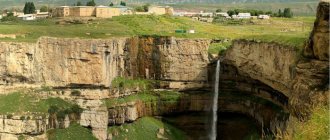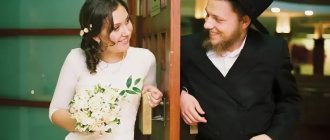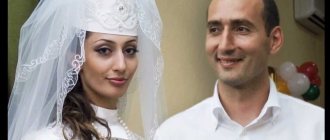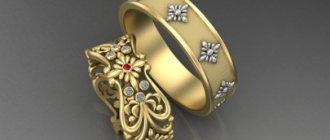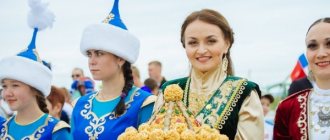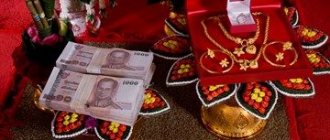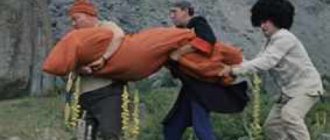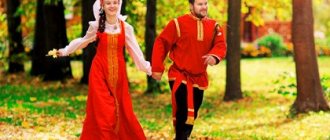What does it consist of?
Content
An Ossetian wedding dress consists of many details. The most significant of them:
- corset;
- decorative bib;
- shirt;
- caftan;
- metal belt;
- apron;
- sleeves;
- veil;
- cap.
The entire suit is made in a swing cut. The caftan is worn over the shirt and tightens the bride's figure. It is almost invisible from under the dress. The caftan fits tightly to the body and prevents the chest clasps from coming undone. They are considered more decorative rather than functional elements of the costume.
On top of the shirt under the caftan, the bride wears a corset. It is fastened with a cord or braid, on which numerous knots are tied. According to tradition, the corset must be untied without the use of sharp objects and the cord must not be broken.
The swing dress features hanging, flared, wide sleeves and a nipped waist. In some decorations, a narrow straight sleeve is allowed, which is noticeably slanted at the wrist. On a narrow sleeve it is necessary to put on wide sleeves from the very elbow.
The Ossetian bride wears a cap on her head, which is framed by a veil and decorated with gold and silver threads. There are many traditions associated with the headdress. It served to ransom the newlywed at the wedding, and if it fell into the wrong hands, it was believed that there would be trouble. The cap is made in the shape of a truncated cone and should be red.
The belt protects the bride from evil glances and the machinations of ill-wishers. It can be made of fabric or silver. The richer the belt, the more abundantly it is decorated with stones, the more prosperous the girl’s family and, therefore, the wealth will accompany the young people all their lives. The fabric belt is a masterpiece of embroidery and decoration, while the metal belt looks like the work of a jeweler.
Celebration
The wedding celebration begins by inviting in advance the respected people who will be in the cortege.
The most venerable one is declared the head of the train, who will take on most of the speeches, as well as solving problems. These men gather a few days before the start of the holiday and discuss all the nuances of the celebration, and also share responsibilities among themselves.
The wedding cortege begins its journey from the groom's house, trying to inform others as much as possible about the reason for their trip. When they reach the bride's house, they are met there by family elders and honorable guests, who present special treats to the visitors:
- three pies;
- beer;
- araka (alcoholic drink made from grain);
- national snacks.
At the moment of donation, praise is offered to God and a prayer is made that this house will always be welcome to visit such esteemed guests. When the leader of the cortege accepts the gifts, he expresses gratitude for the greeting. After this, the man blesses the families who are going to become related.
The rest of the men who arrived should do the same. After all the gifts have been handed over, the guests are brought into the house, where a laid table with treats awaits. It is desirable that there are many different dishes present. This will show that guests are welcome, and good housewives live in the house. When everyone is seated, songs and toasts begin, while the mother of the bride tries to make the eldest of the train feel comfortable.
It is important to remember that if there is a family in mourning near the bride’s house, then the girl’s father must send them a letter a few weeks in advance.
It says that a celebration is planned, but he respects the grief of others and does not know what to do correctly. After that, they send him a response in the same way with permission to celebrate, because they respect other people’s happiness.
When some time has passed, the head of the train asks for three ribs of a sacrificial ram. After they are brought to him, he divides them and hands them along with the glasses to the women of the clan. At this time, three toasts are made:
- Praising the women and girls who prepared the festive treat.
- To all guests.
- The eldest woman in the bride's family.
At this time, some of the women help the bride to dress up, and when she is ready, it is announced. After this, the elder must pay the agreed ransom, and only after that the girl will be shown to them. At the same time, it is desirable that during the bargaining process emergency situations occur that will amuse everyone present.
After the bride is handed over to the newcomers, they go to the groom's house.
When the motorcade enters the courtyard, the car is surrounded by young people who sing funny songs and joke. The bride is brought to 3 older men who read a prayer to God in gratitude for the joyful event. After this, the bride is helped to carry out the process of removing the veil and taken to the house where the 3 oldest women are sitting.
Before she crosses the threshold, she is given a little boy to hold, so that the first child will be male.
After this, she must step over the threshold, and it is important that she enters the house with her right foot without tripping.
When the girl is under the roof, she immediately bows deeply to each elder, showing respect. In response, she hears prayers to God, in which they thanked him for such a well-mannered girl. Next, the bride is escorted to a designated room and dancing is arranged. After a certain time, the train foreman comes for the bride and takes her out into the yard to remove the veil.
This is done by a young unmarried youth who is a close friend or relative of the groom.
He removes the veil using a special flag sent from the bride's home. At the same time, he wishes her fertility, many sons and one daughter. The flag used to remove the veil is solemnly hung in the house above the stove.
After the bride's veil is removed, she must present the elder women with a bowl of honey, which was sent from her parents' house.
At the same time, the elders want her to have the same sweet life in marriage. Next, the girl is escorted to a room where dancing and singing continue.
While the bride is being welcomed into the groom's house, the man comes with a witness to the bride's house. They are waiting for him there, because everyone is interested in how the new relative will turn out. A guy should show modesty and moderation in food and alcohol so as not to show himself in an unattractive light. It is after this banquet that his relatives and neighbors will determine their opinion towards him.
A man, having arrived at the house, must present the women with candies or other sweets. After this, in the midst of the celebration, he and two friends ask to get up from the table, looking at the women. There they are given 3 glasses, and they must make 3 toasts to the hostesses, and then fill the dishes with money. The men return to the table and continue to celebrate.
The fun often ends after midnight when the new relative leaves for the older train's house.
Peculiarities
The image of the Ossetian bride is richly decorated with symbols. First of all, it contains a symbol of fertility, since the main purpose of a woman is procreation.
The bride's dress is decorated with embroidery resembling branched horns. It decorates the edges of the robe and serves as a powerful amulet. The cap on the newlywed's head is also decorated with amulets - they are embroidered with gold and silver threads and decorated with bright stones, preferably a ruby hue.
The dress is divided into three parts: top, middle and bottom. In the wedding attire, the Ossetian bride's outfit has zones that are divided by a cap, a collar and a belt.
It was believed that on the wedding day the bride was especially susceptible to the machinations of evil spirits and was very vulnerable. That is why the abundance of amulets and protective symbols is considered a special feature of a wedding dress.
Arrival for the betrothed
A few years ago, a wedding in Ossetia was celebrated in the groom’s house. Many guests were invited to the event. The festive table was placed in the courtyard. In modern times, young people prefer to celebrate their wedding in a restaurant.
An Ossetian wedding is conventionally divided into two types: the celebration of the bride and groom. In the morning, the future spouse's relatives, neighbors and friends come to his house. The eldest of the best men decides who will go in the cortege to pick up the bride, and also gives several instructions. It is mandatory for the girl's parents, senior and junior groomsmen to follow her. The retinue gives the groom's chosen one pies, cakes, sweets and alcoholic drinks.
They are greeted at the doorstep with glasses of wine. The guests wish the bride and groom well, happiness and long love. Then everyone goes into the house. The bride occupies a prominent and honorable place. But after a few minutes she is taken to an adjacent room, where she can change into a wedding dress.
Colors and fabrics
The caftan in traditional outfits is made from expensive natural fabrics. Mostly it is silk, satin or velvet. The sides of the caftan, hem and collar are decorated with galloon and gold embroidery. The belt could also have various decorative elements. Under the caftan, the newlywed wears a cotton or silk shirt of yellow or red color. The corset for the caftan is made of silk folded in several layers.
The swing wedding dress was originally made from red material. But fashion has made its own adjustments. Today, the Ossetian bride's outfit is made in light colors with bright elements. You can meet Ossetian women in cream, blue, and pink wedding dresses. But still, most girls prefer snow-white wedding national decorations made of expensive materials.
Accessories and shoes
Ossetian wedding dress is decorated with precious stones, silver and embroidery. This makes the outfit not only rich and luxurious, but also quite heavy. Precious stones should be replaced with decorative artificial elements. For example: Swarovski stones, rhinestones, pearls or beads.
The outfit should traditionally come with a silver belt. It is decorated with gilded ornaments and embossing. The belt can also be decorated with red stones.
The Ossetian bride wears chuvyaki on her feet - soft national shoes made from natural fabrics. Following strictly traditions, chuvyaki should be made from a single piece of morocco and decorated with national ornaments. The patterns are embroidered with gold and silver threads.
The bride's veil can be replaced with a transparent scarf. It is put on over the cap and completely hides the girl's face. After the wedding ceremony, this scarf is removed, and instead of it, the cap is covered with a red velvet piece of fabric.
